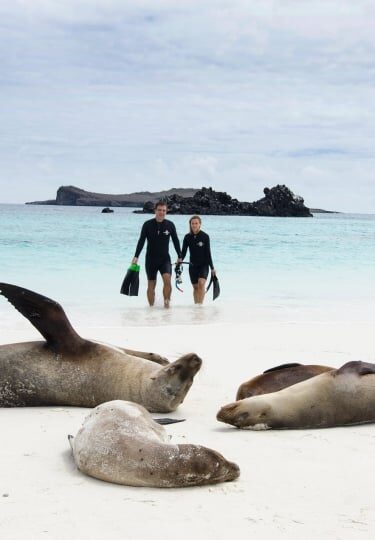You’ll find some of the most beautiful beaches in the world in the Galapagos Islands. Long sweeps of pristine sands come in shades of coral white, gold, pink, red, and even green. Volcanic rocks frame picturesque bays, while colonies of sea lions bask on the shore, overlooked by craggy iguanas standing like statues on the rocks.
What you won’t find are any facilities. No beach bars, no sun umbrellas, no loungers—and on the vast majority of beaches, no other visitors, as entrance to the national park sites is strictly regulated.
This is the joy of Galapagos beaches. As the saying goes, here, you take only photographs and leave only footprints.
You’ll arrive at each beach by panga, or inflatable dinghy, bringing everything you need, from water shoes and snorkel gear to sea kayaks, water, and camera. Then you’ll take it all away again. This really is the purest beach experience you could hope for; nature at its most untouched.
Here are 10 of the best Galapagos Islands beaches to enjoy.
Las Bachas, Santa Cruz Island
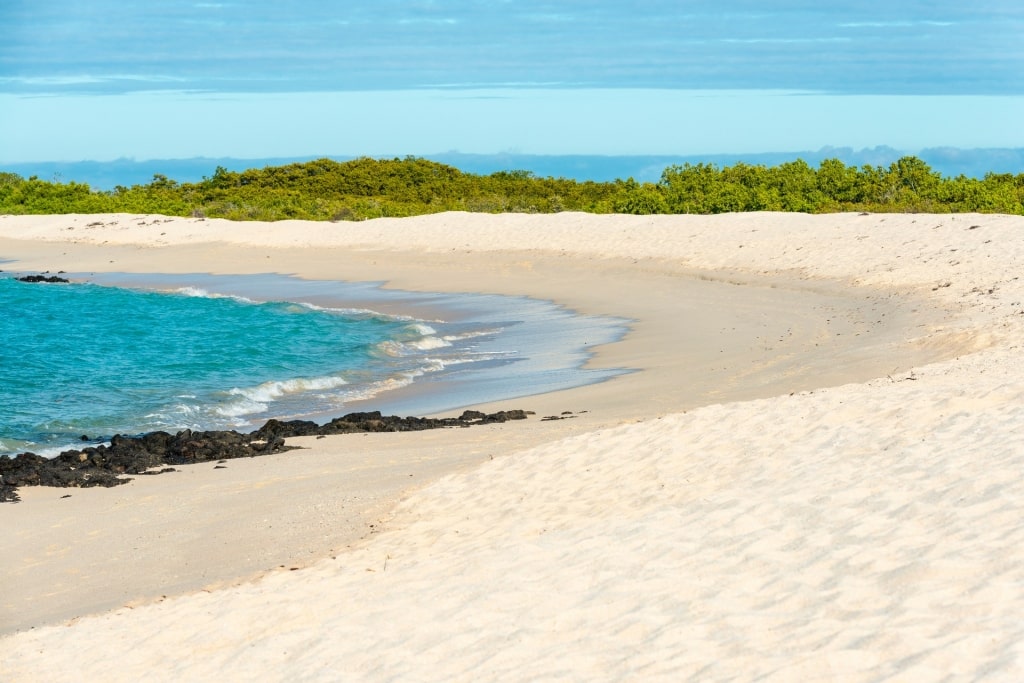
Las Bachas, Santa Cruz Island
Las Bachas, on the north shore of Santa Cruz, is a dreamy-looking beach; a long sweep of pale sand with only the gentlest of waves, perfect for swimming. Just 10 minutes or so inland are two tranquil lagoons where you could spot pink flamingos feeding.
Look out for turtles on the beach, too; they come here to lay their eggs in the sand. If you see a turtle, give it plenty of space.
For a female, leaving the safety of water and hauling up the slope of the beach, digging a hole and laying eggs is a strenuous and risky exercise. Even if you don’t spot turtles, you’ll spot their distinctive tracks, so you know where the nests are.
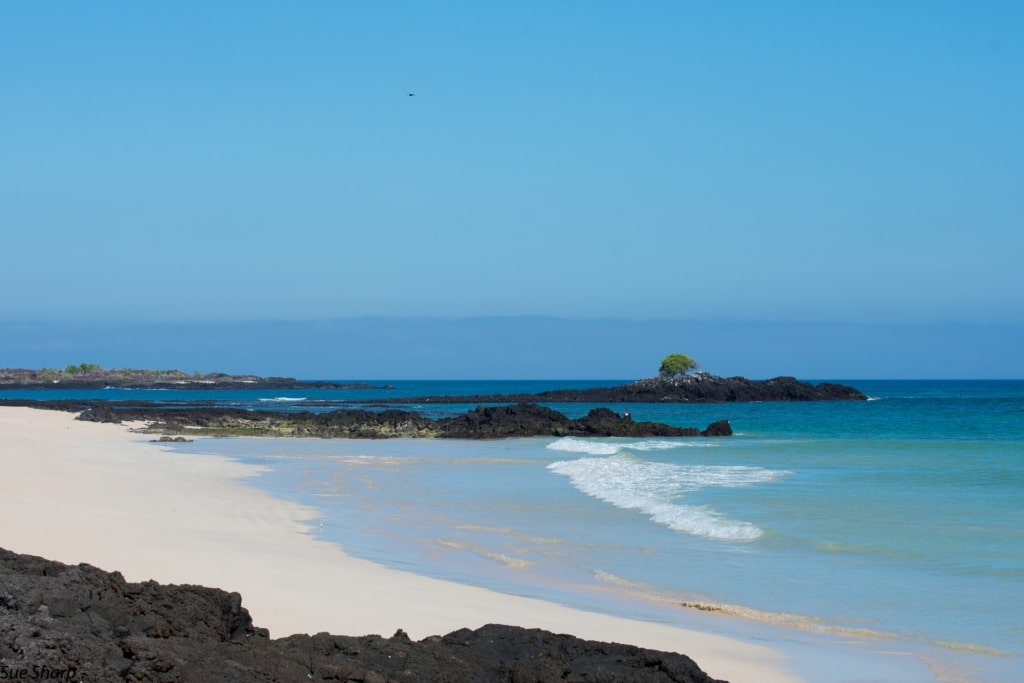
Las Bachas, Santa Cruz Island
The beach gets its name from a mispronunciation of “barges”; two American barges, relics from WWII, broke free of their moorings and ran aground here in the 1950s, slowly disintegrating. You can still see the skeletal remains of one of the barges in the sand.
Tortuga Bay, Santa Cruz Island
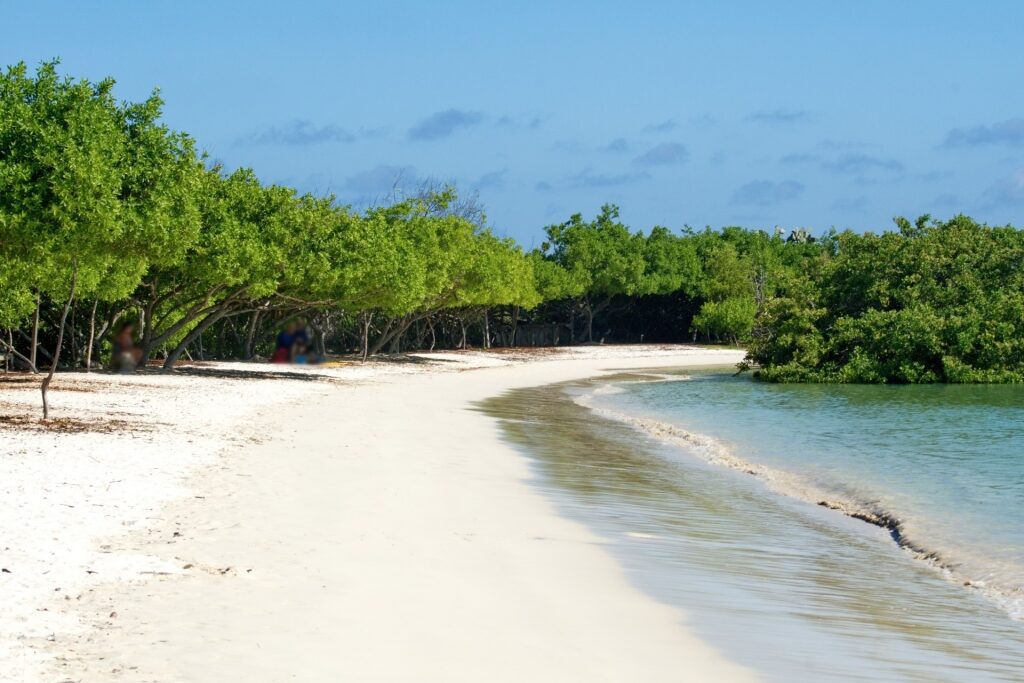
Tortuga Bay, Santa Cruz Island
The seemingly endless stretch of Tortuga Bay, on the south side of Santa Cruz Island, is a beautiful sight; a sweep of pure white sand sloping gently into turquoise water. Strong currents mean you can’t swim here, but it’s a magnificent place for a beach stroll.
Look out for pelicans and blue-footed boobies perched on the rocks at the end, as well as majestic marine iguanas, which plunge into the water every now and then to feed on algae.
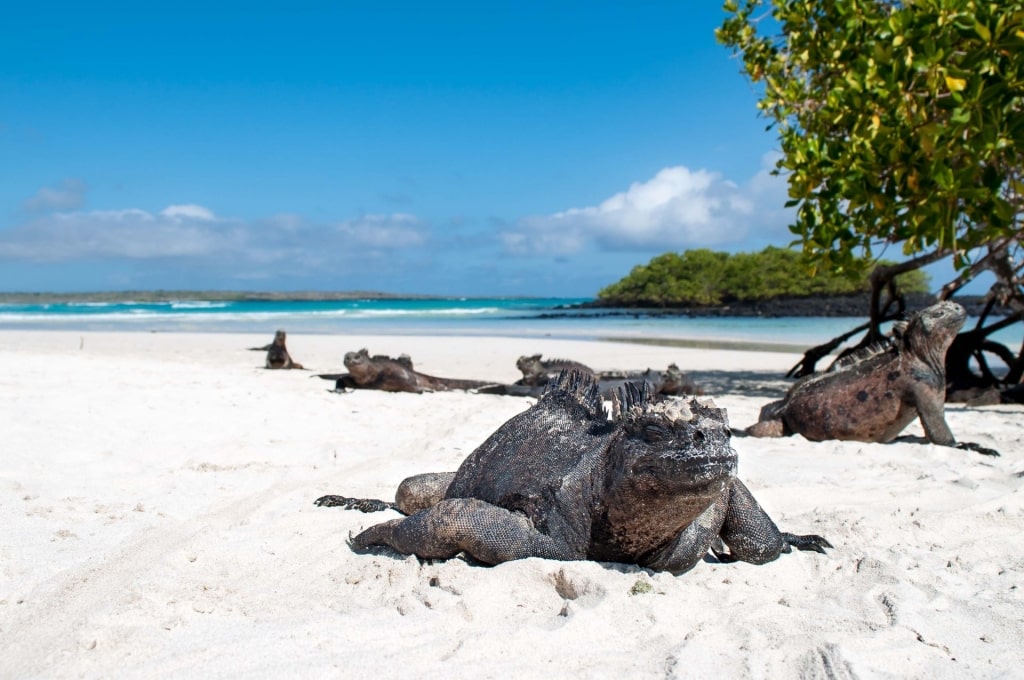
Marine iguana in Tortuga Bay, Santa Cruz Island
Tortuga Bay is different from other Galapagos Islands beaches in that it’s accessible by foot from the little port town of Puerto Ayora. You may see other people here, although this being the Galapagos, it will never be anywhere near crowded.
There could even be surfers on the main beach, as the waves are good here; they make an incongruous sight in the midst of all the wildlife, indifferent to the antics in the water.
If you want to swim, there’s a trail through the mangroves to nearby Playa Mansa (or you can simply follow the beach), where you’ll find a peaceful tidal lagoon. Take a dip here and you may spot small white-tipped reef sharks, which will keep out of your way.
Post Office Bay, Floreana Island
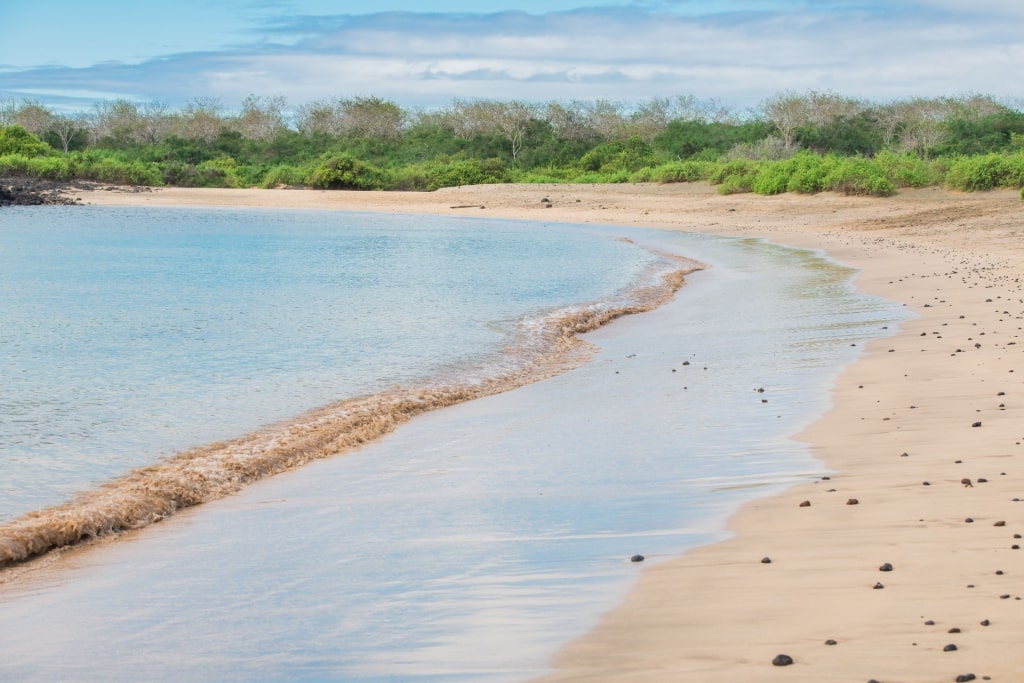
Post Office Bay, Floreana Island
A short walk from the landing site on Floreana, you’ll find an odd-looking cluster of barrels and boxes in front of the undergrowth. This is the legacy of a unique mailing system that developed in the late 18th century.
Whaling ships would stop by, many of their mariners having been at sea for years. The homesick sailors would leave a letter for family back home in the barrel, in the hope that a ship that was homeward bound would pick it up and deliver it.
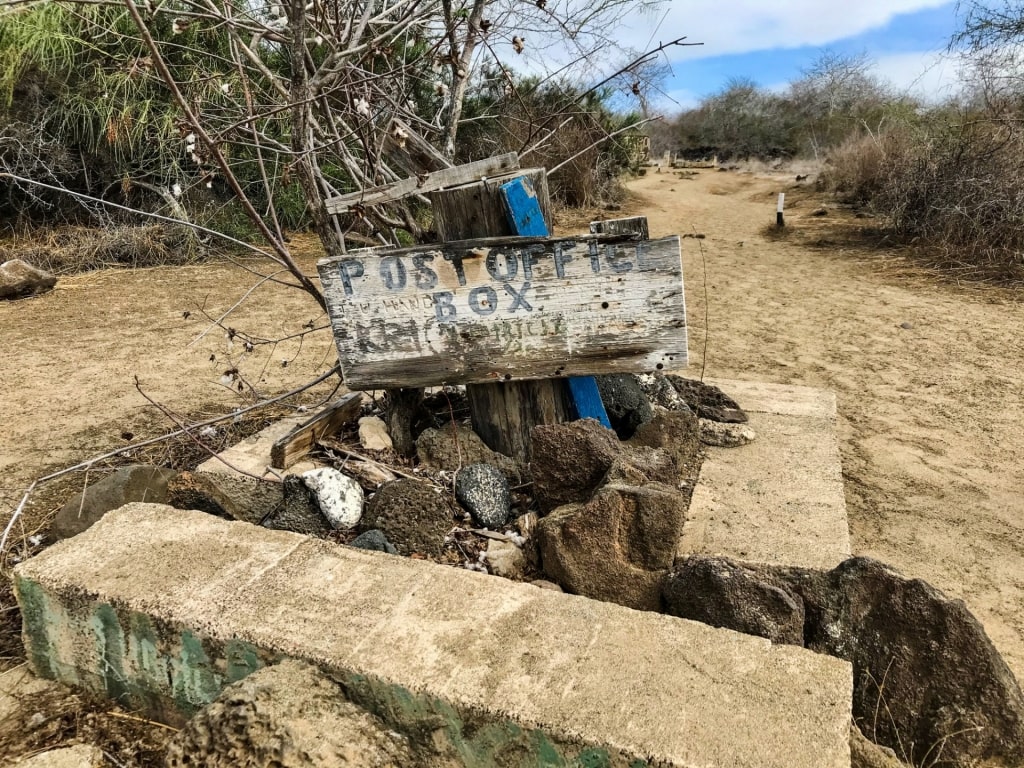
Post Office Bay, Floreana Island
The system worked then and it still does today. Expedition guides will hand out postcards from the box to anyone from the town or country for which the cards are destined. In turn, you can leave your own card and see how long it takes to get home. There’s something of a thrill when friends receive mail that has made its way via such an unusual route.
After the card ceremony, spend some time on the half-moon of golden sand at Post Office Bay, where you can swim and look out for rays and sea lions.
If your time on Floreana offers an opportunity to head further around the coast to Cormorant Point, take it. You’ll have a chance to admire yet another dazzling Galapagos beach, this one made of glittering green sand, created by the presence of olivine crystals in the rocks.
Espumilla Beach, Santiago Island
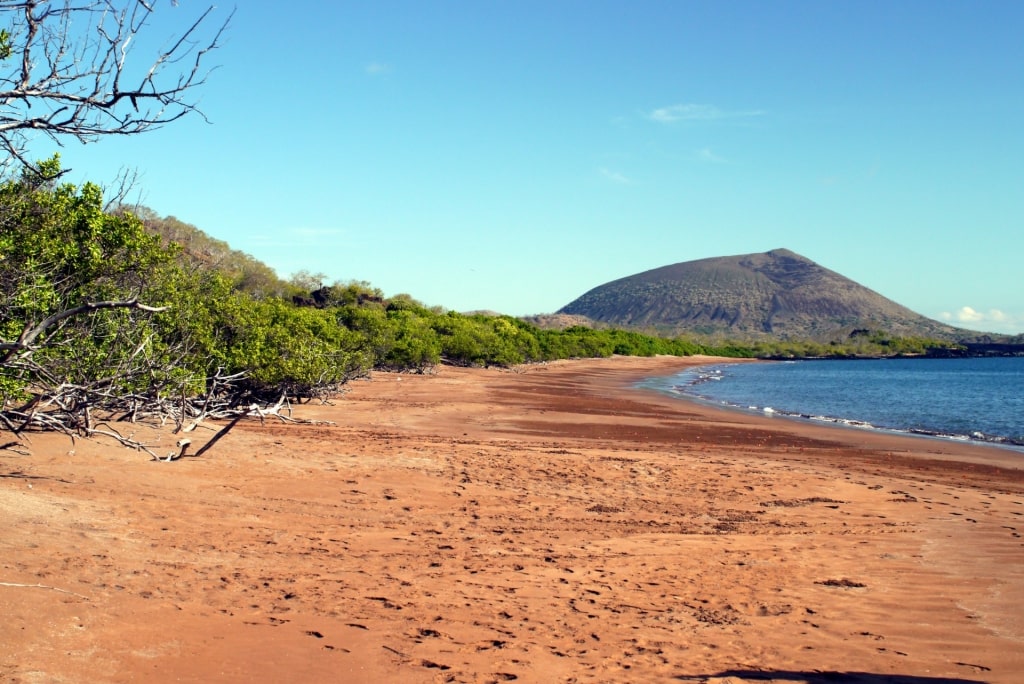
Espumilla Beach, Santiago Island
On the northern edge of James Bay, Santiago Island, Espumilla Beach is a glorious stretch of dark gold sand. For the Galapagos, the landscape here is relatively lush, with tall Palo Santo trees and dense mangroves fringing the shore.
The beach is a nesting site for sea turtles, so keep a wide berth of any turtles on the sand and be careful not to disturb nests. You may see turtles gliding through the clear blue depths in the water, as well as sharks and rays.
After a swim, follow the hiking trail with your guide to a bright green lagoon, where you could spot pin-tail ducks and, if they happen to be visiting, flamingos.
Puerto Villamil, Isabela Island
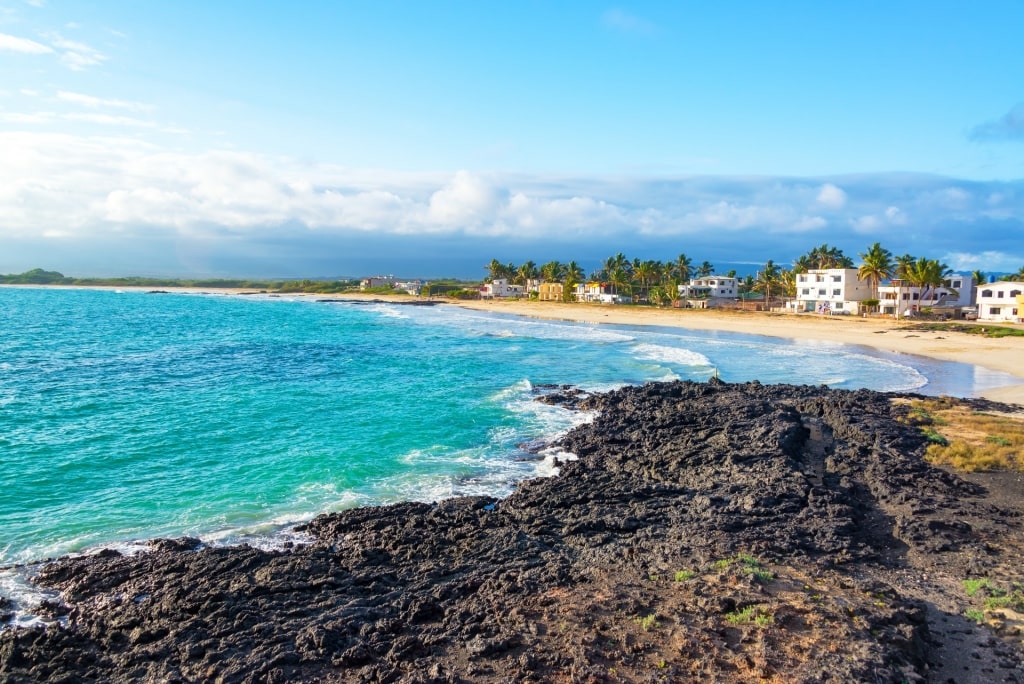
Puerto Villamil, Isabela Island
Puerto Villamil on Isabela Island is one of the few settlements in the Galapagos—little more than a village, really, with just 1,700 inhabitants and a cluster of hotels and laid-back beach bars.
The town stretches out along a glorious golden beach fringed with palms. You can swim and snorkel here, or simply relax among the sea lions.
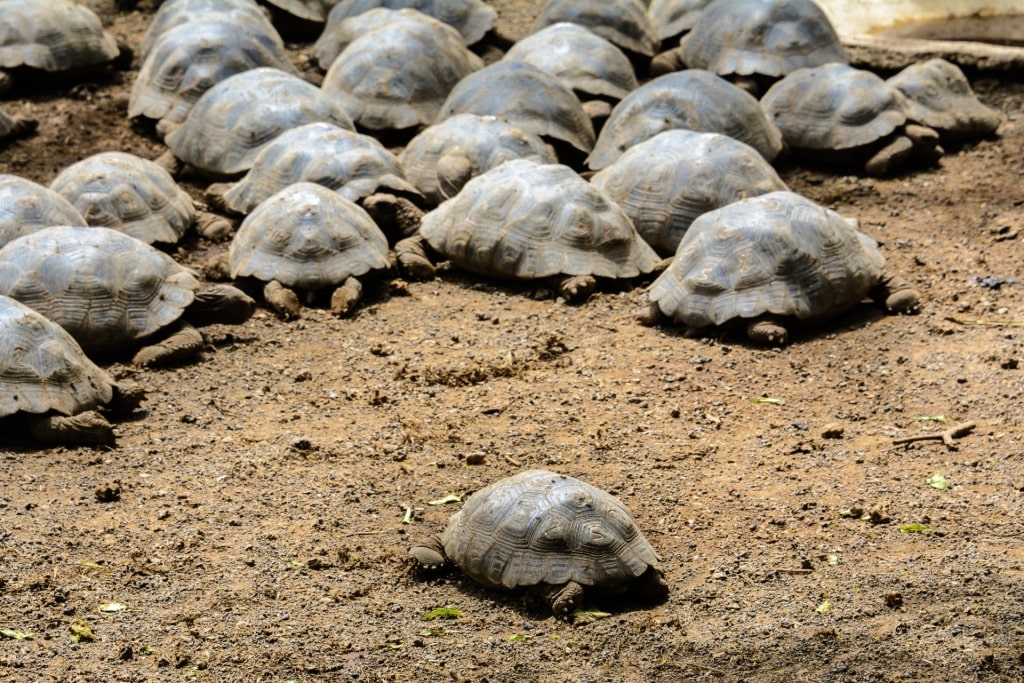
Arnaldo Tupiza Tortoise Breeding Center
While you’re here, don’t miss the trail to the Arnaldo Tupiza Tortoise Breeding Center, about a mile’s stroll over a boardwalk that takes you through the wetlands, rich with Galapagos birdlife.
This captive breeding center works to protect the five subspecies of Galapagos Giant Tortoise, which is native to Isabela but severely threatened.
Babies are hatched in incubators, and some 350 adults and juveniles are being reared in spacious corrals and fed on the diet they would eat in the wild. The center acts as an educational facility for locals as well as a visitor attraction.
Red Sand Beach, Rabida Island
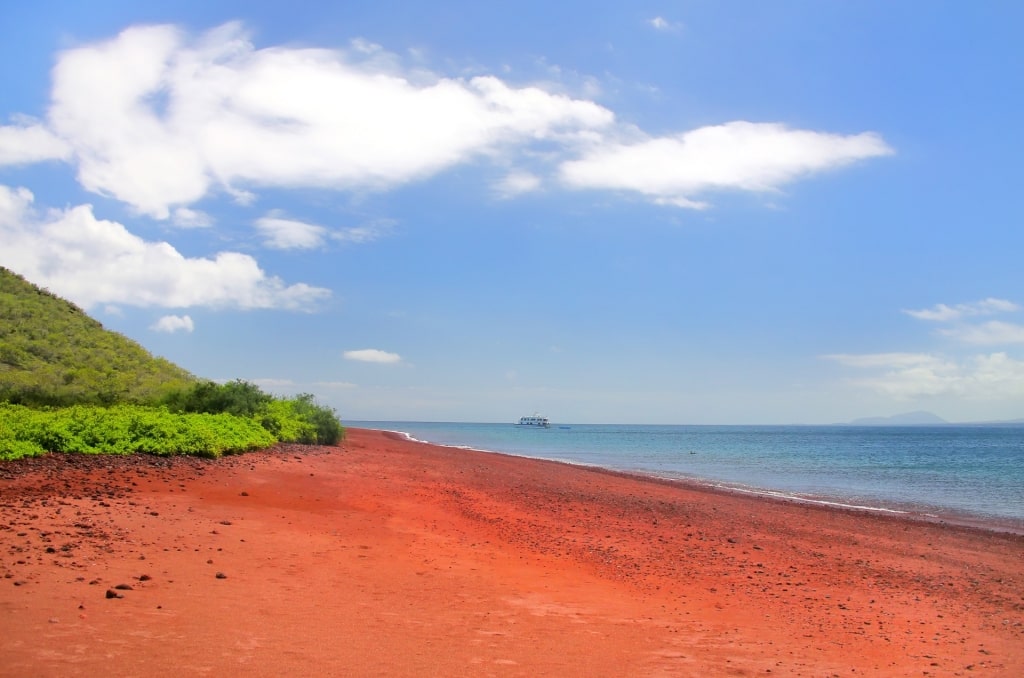
Red Sand Beach, Rabida Island
One of the most astonishing things about Galapagos beaches is that there’s such variety in color in a relatively small area. While some beaches are yellow, others coralline white, and some a glittering green, Red Sand Beach on Rabida Island is, as its name suggests, a rusty red. This is due to the presence of iron in the lava that created this small, rocky island.
You’ll land in shallow water on the beach, where there’s plenty to see. The snorkeling is excellent here, with a good chance of spotting sea lions, rays, sea turtles, and eels.
Rabida is also a great place to see brown pelicans nesting in the brush behind the beach. There’s something endearing about pelicans; in the towns of the Galapagos, they’ll come right up to the fish stalls in the markets like hungry dogs and beg for scraps. Here, you can see them in a more appropriate habitat.
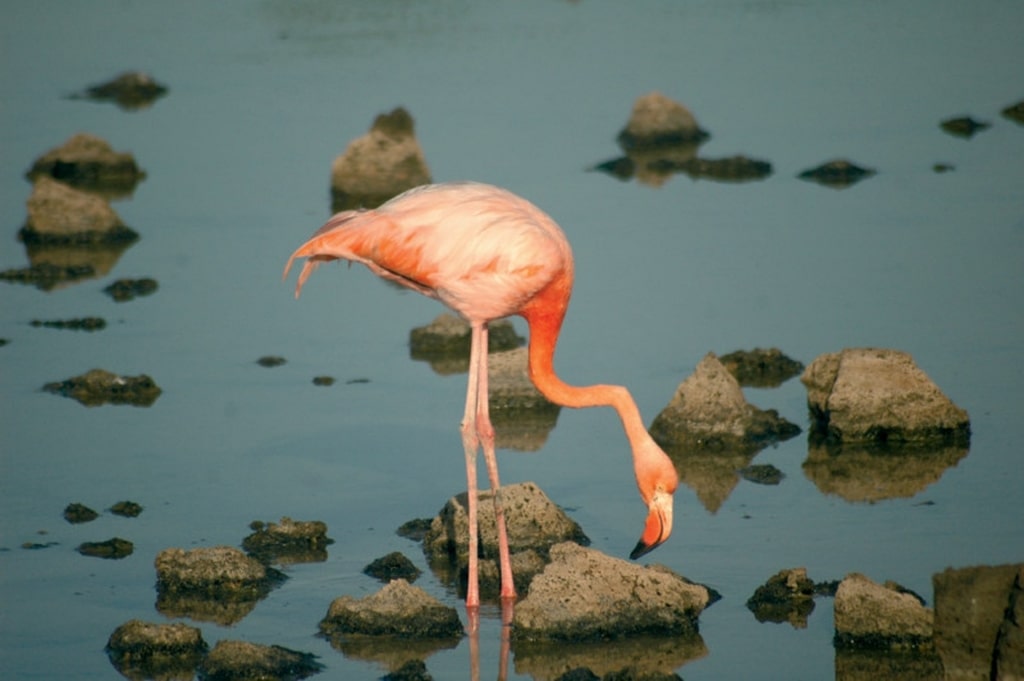
Flamingo
Rabida is also known for its flamingo population, which feeds in the saltwater lagoons near the beach. The flamingos get their distinctive color from the shrimp larvae in their diet. They’re not always here, though.
As an alternative, head on a nature walk inland through the Palo Santo trees, on the lookout for yellow warblers, Galapagos doves, and finches.
Puerto Egas, Santiago Island
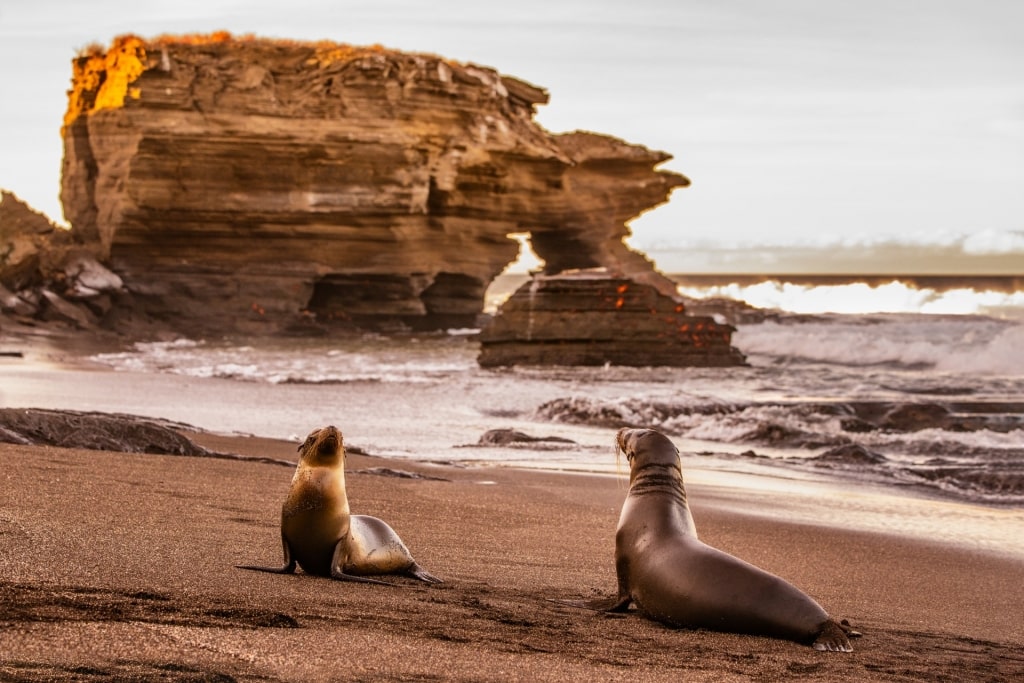
Puerto Egas, Santiago Island
Charles Darwin visited rocky Puerto Egas in 1835, although sadly, he reported coming across a group of Spaniards eating tortoise meat, something that would be unthinkable today. Later, an entrepreneur after whom the port is named opened a salt mine here.
Luckily, Puerto Egas today is protected from such desecration, as is all of the Galapagos. It’s a top wildlife watching place, with rich birdlife along the shore and in the rocks, from blue-footed boobies to lava herons, finches, and oystercatchers.
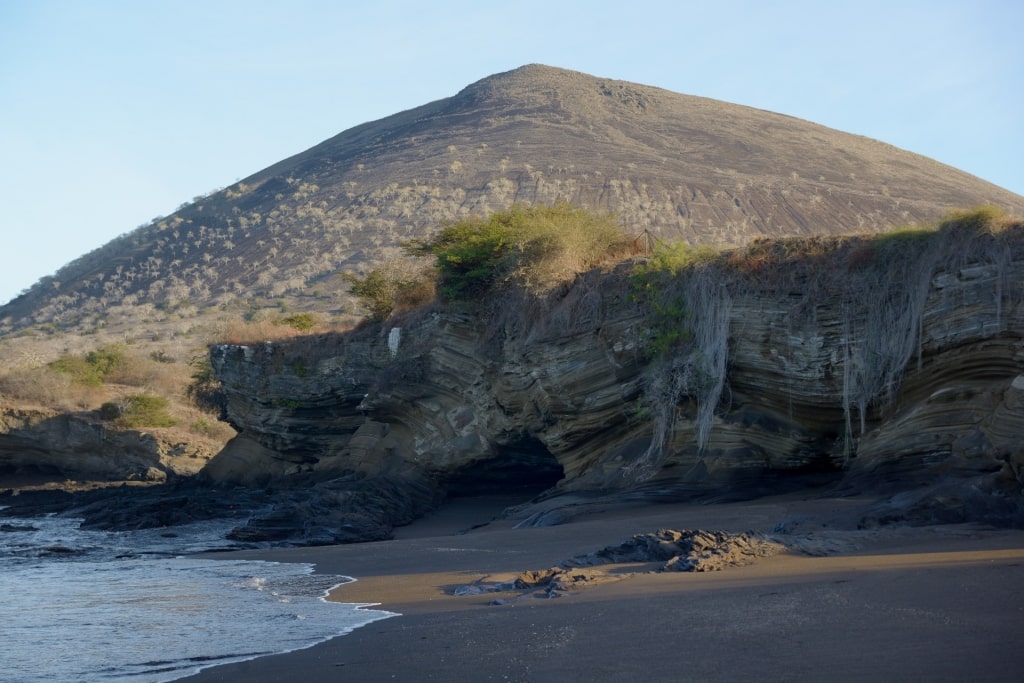
Puerto Egas, Santiago Island
The beach here is black sand, dotted with tide pools between the jagged rocks, sea caves in the lava cliffs inviting exploration and beautiful photographs.
As you hike along the wide, rocky trail with a guide, look out for fur seals, much less common than the ubiquitous sea lions, as well as sea turtles and large colonies of marine iguanas.
Take time to peer into the tide pools, which trap an exquisite little ecosystem of their own as the water recedes. You’ll also see the remains of the salt mine, now little more than a few dilapidated buildings and a shallow salt-water lake that may be populated by flamingos.
Mosquera Islet, near Baltra
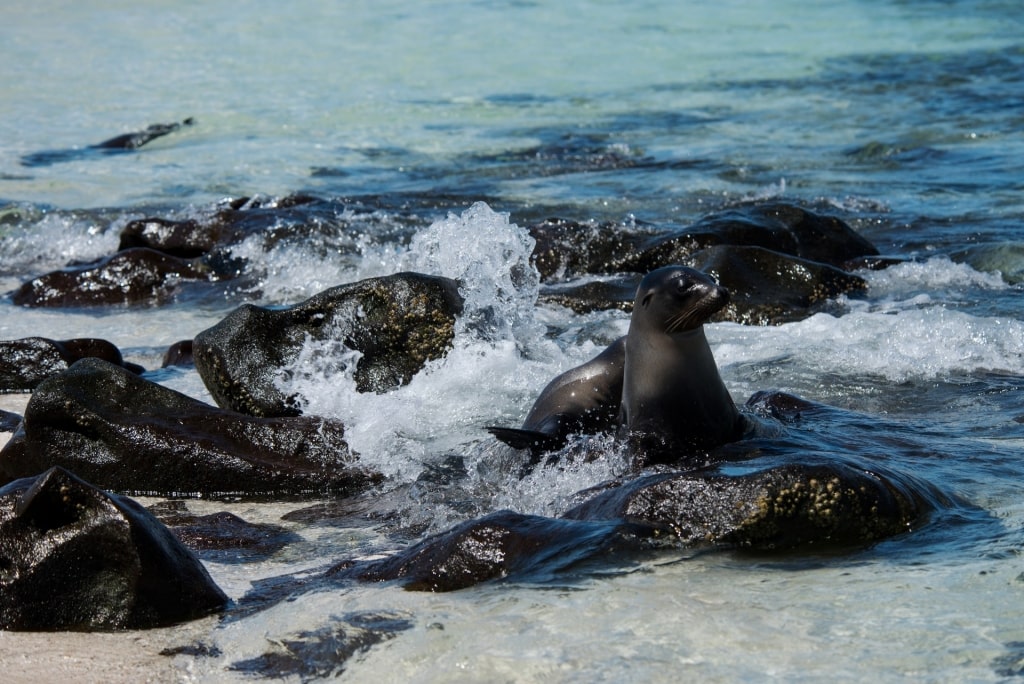
Mosquera Islet, near Baltra
A tiny, sandy island located between Baltra and North Seymour, Mosquera Islet is one of the best places in the Galapagos to observe sea lions up close.
Yes, you do see them everywhere, but sit on the soft coral sand here for a while and watch mothers with their pups, or marvel at the tiniest of big-eyed pups just left in the sand as their moms head out to sea to feed.
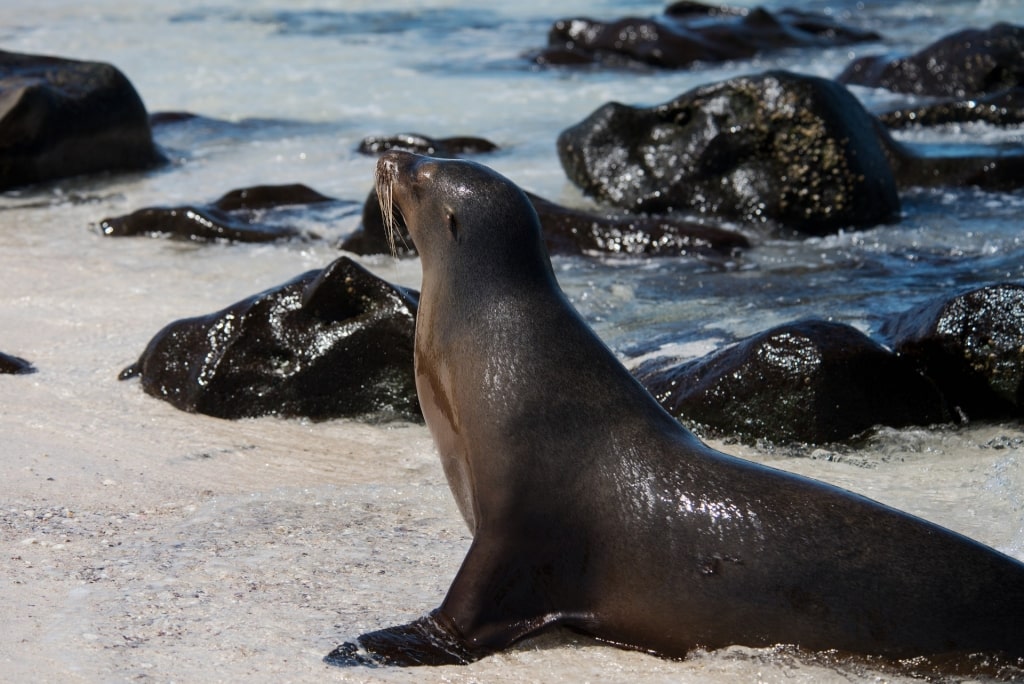
Mosquera Islet, near Baltra
Alpha males patrol the shore, barking to ward off competitors. Juveniles may well join you in the water for a swim, dashing around you like playful puppies, coming right up to you and eyeballing you through your mask, and then spinning around and zooming away.
As always, you’re expected to keep your distance from Galapagos animals and give way to them, but sometimes it’s difficult, as there are so many sea lions hauled out on the beach.
Bartolomé Island Beach, Bartolomé

Bartolomé Island Beach, Bartolomé
Pinnacle Rock in Bartolomé Island is one of the most photographed images in the Galapagos, a volcanic spike jutting out of the sea at one side of an isthmus formed of two curves of pinky-gold sand. These two curves are also some of the most beautiful Galapagos beaches.

Bartolomé Island Beach, Bartolomé
You can swim and snorkel from the northern beach on the isthmus, where there’s a good chance of some curious Galapagos penguins joining you in the water, especially around Pinnacle Rock itself.
The penguins zoom around like bullets underwater and are completely fearless of humans; you may lift your head out of the water for a breather from snorkeling and find yourself surrounded. Green turtles nest in the sand here, too, making it a great place to visit if you’re in the Galapagos with kids.
There’s no swimming allowed off the southern beach, but it’s a lovely spot for a stroll and you could see the shadowy figures of stingrays in the gentle surf.
If you want to capture that iconic shot of both beaches, the peninsula and the pointed rock, one of the best things to do in the Galapagos is to take a short hike up the hill for the best views.
Gardner Bay, Española

Gardner Bay, Española
A long, white stretch of coralline sand makes Gardner Bay the perfect spot for some beach time and snorkeling in the Galapagos. The sand shelves gently, so it’s easy for less confident swimmers to splash around in the shallows.

Gardner Bay, Española
You’ll have several colonies of sea lions for company. You may spot sea turtles, too, gliding through the blue depths. If you decide to snorkel or take a kayak out, head for the small island in front of the beach, where there’s a lot of wildlife, including iguanas and orange-and-red Sally Lightfoot crabs.
Don’t be surprised if a curious bird approaches you and even lands on you. These are mockingbirds and, like other Galapagos wildlife, they have absolutely no fear of humans. Often, they’re looking for water and may peck at your water bottle.
Read: Best Time to Visit the Galapagos
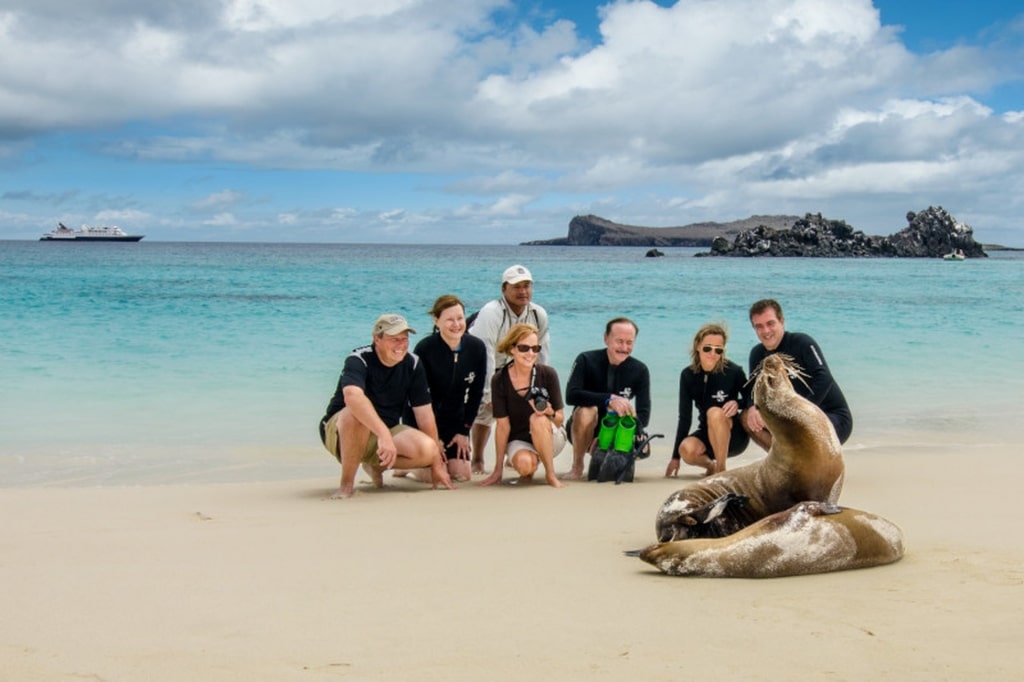
Galapagos
Inspired to visit the pristine paradise of the Galapagos and spend time exploring some of the world’s most beautiful beaches? Browse our cruises to the Galapagos and plan the voyage of a lifetime.
